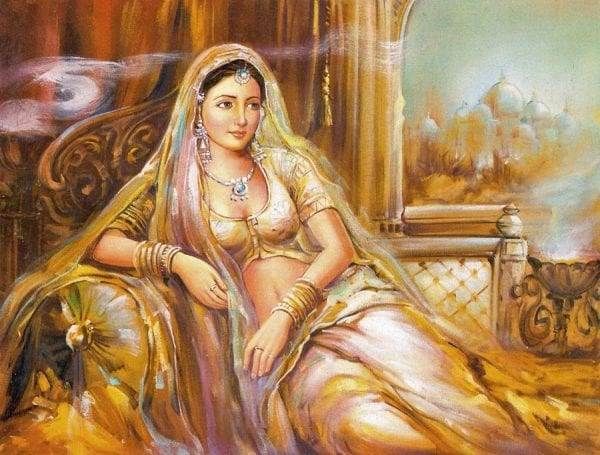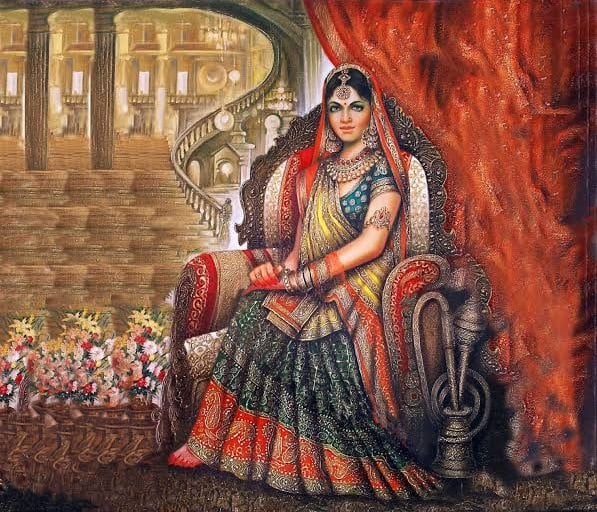Rani Padmavati vs Alauddin Khilji: The Heroic Tale Behind Chittorgarh’s Fall
Khilji reached Chittorgarh under the guise of friendship and expressed a desire to see Rani Padmavati. Knowing Rajput customs forbade such acts, she agreed to let him see her reflection through a mirror in the palace. The brief glimpse inflamed Khilji’s desire, and he began plotting to possess her at any cost.
HISTORY
4/5/20255 min read


Rani Padmavati: The Eternal Flame of Honor and Rajput Valor
Rani Padmavati, also known as Queen Padmini, is not just a character from folklore — she is a symbol of Rajput pride, feminine courage, and civilizational resistance. Her story is celebrated in poetry, oral traditions, paintings, and history books. While debates rage over historicity, the essence of her saga has inspired countless generations to uphold dharma, honor, and national pride. The story of Padmavati is not merely about a queen — it is about the soul of Bharat standing tall in the face of tyranny.
The Royal Origins of Rani Padmavati
Padmavati is said to have been born in the ancient kingdom of Singhal, believed to be present-day Sri Lanka or a symbolic realm representing a culturally rich and distant land. Her father, King Gandharvasen, ensured that she received a royal upbringing not just in etiquette and fine arts but also in warfare, administration, and diplomacy. This sets her apart from typical portrayals of queens — she was an educated, warrior-like woman rooted in dharma.
Padmavati’s beauty, described as celestial in Jayasi’s Padmavat, was only one of her attributes. She was also known for her sharp intellect, strategic mind, and compassion toward her people. From a young age, she was exposed to debates, dharmic discourses, and spiritual practices — a hallmark of royal education in ancient Indian tradition.
One of the most unique aspects of her story is her association with a talking parrot named Hiraman. While some consider this metaphorical, the symbolism is profound: it suggests her fame and aura were so powerful that even nature could not help but spread the word about her. Hiraman becomes the bridge between her quiet life in Singhal and the grand drama that unfolds at Chittorgarh — a reminder that destiny often calls the great from distant lands.
Chittorgarh: The Bastion of Rajput Honor
After her swayamvar, Padmavati became the queen of Mewar by marrying Maharawal Ratan Singh. She then moved to Chittorgarh, the citadel of Rajput resistance and one of the most formidable forts in India. Built on a 180-meter-high hill and sprawling across 700 acres, Chittorgarh wasn’t just a military stronghold — it was the cultural and spiritual capital of Rajputana.
The fort housed magnificent temples dedicated to Devi, Shiva, and Vishnu, reflecting the deep religiosity of the Rajputs. Rani Padmavati, as queen, participated in daily rituals, state decisions, and even military discussions. Rajput women were trained to rule in the absence of their kings, and Padmavati fully embodied that legacy.
Her time at Chittorgarh wasn’t merely ornamental. Folk songs and ballads portray her as a wise queen who offered counsel during political crises. She was respected by nobles and feared by rivals. Her presence elevated Chittorgarh from a political capital to a sacred fortress.
The people of Mewar revered her as a “Rajmata” in spirit — a guiding force for cultural and spiritual strength. Her beauty may have drawn attention, but it was her nobility and unwavering character that made her a living legend.
Alauddin Khilji's Obsession and Attack
Alauddin Khilji was one of the most powerful and ambitious rulers of the Delhi Sultanate. He had already conquered much of North India and sought to dominate Rajputana, which stood defiantly in his path. It is said that Raghav Chetan, a disgraced musician expelled from Ratan Singh’s court, told Khilji about Padmavati’s unmatched beauty in a bid for revenge.
Obsessed with power and domination, Khilji saw Padmavati not just as a woman but as a symbol of Rajput pride — and conquering her would mean psychological warfare against Hindu resistance. He marched toward Chittorgarh with a massive army under the pretense of forming an alliance.
When he arrived, he played a political game. He expressed a desire to see Padmavati — something that violated Rajput customs, where women lived in purdah (seclusion). Out of diplomatic courtesy and strategic foresight, Rani Padmavati allowed Khilji to see her only via a reflection in a mirror. But that single glimpse ignited his lust and thirst for conquest even further.
This was not about love — this was about subjugation. For Khilji, capturing Padmavati would be the equivalent of humiliating an entire race and religion.
Ratan Singh’s Abduction and Padmavati’s Tactical Brilliance
After the mirror incident, Khilji invited Ratan Singh to his camp for discussions — and treacherously imprisoned him. He then sent an ultimatum to Chittorgarh: surrender Padmavati, or the king would be executed.
Here begins a lesser-known chapter of the story — the strategic genius of Rani Padmavati. She immediately devised a rescue plan involving two Rajput warriors, Gora and Badal. Disguised as Padmavati’s attendants, they entered Khilji’s camp with palanquins — each carrying armed soldiers instead of women.
The ambush caught Khilji’s guards off guard. In the fierce battle that ensued, Ratan Singh was rescued, though many warriors, including Gora, sacrificed their lives.
This event proves that Padmavati was not just a passive queen but a war-time leader capable of high-risk decision-making and clever warfare — a Rajputani in every sense.
The Siege of Chittorgarh and the Fire of Resistance
Insulted and enraged, Khilji returned to Delhi but soon came back with a larger force in 1303 AD and laid siege to Chittorgarh. The fort held out for months. Cut off from supplies, with disease and starvation creeping in, the morale began to fade — but not the spirit.
Inside the fort, the people knew that defeat was inevitable. The Rajput code of honor forbade surrender. They believed in living with dignity or dying with it. With invaders at the gate, Padmavati made her final decision — to embrace Jauhar.
Jauhar: The Ultimate Assertion of Sovereignty
Jauhar was not just self-immolation — it was an assertion of honor. In the face of certain enslavement, dishonor, and forced conversion, Padmavati and 16,000 women chose to walk into the sacred fire. They dressed in bridal red, chanted Vedic mantras, and offered themselves to Agni, the god of fire.
This was not a defeat. This was civilizational defiance. The Rajputs believed that while you may lose a fort, you must never lose your soul.
Simultaneously, the men performed Saka — the ritual of charging into battle knowing death awaits. They fought bravely till the last drop of blood, transforming the battlefield into a tirtha — a sacred site of sacrifice.
The flames of Jauhar became the flames of resistance. Padmavati did not die — she rose like a phoenix in the cultural memory of India.
Cultural Legacy: Padmavati in Folk Memory and Literature
Rani Padmavati’s tale was immortalized by Malik Muhammad Jayasi in his epic Padmavat in 1540. While poetic in nature, it reflects deep cultural truths. In Rajasthan, her story is not fiction — it is sacred lore. Her name is chanted in folk songs, and her Jauhar is commemorated in the annual Jauhar Mela at Chittorgarh.
Women look up to her as a symbol of dignity, and men remember her as the embodiment of Rajput honor. Her story has been retold in temples, folk plays, and classical art, where she is always seen as a Devi-like figure — fierce, pure, and fearless.
Historical Perspective: Beyond Myth and Legend
While modern historians debate over the historicity of Jayasi’s account, the siege of Chittorgarh by Alauddin Khilji in 1303 is well-documented in Muslim chronicles like Amir Khusrau’s works. Though Khusrau omits mention of Padmavati (possibly to preserve Khilji’s image), regional bardic traditions and oral histories fill in the gaps.
In Indian tradition, history is preserved through itihasa (sacred history) — a blend of fact and dharma. The spirit of Padmavati’s tale is undeniably real — a truth passed down through the blood and fire of generations.
Conclusion: A Flame That Still Burns
Rani Padmavati’s story is more than just a historical account — it is the story of every Indian who values honor over submission, dharma over defeat, and spirit over survival. She was not a victim — she was a warrior queen who walked into the fire not to be forgotten, but to be forever remembered.
"When Chittor burned, Bharat awakened.
And in the flames of Jauhar, rose a goddess of resistance."

